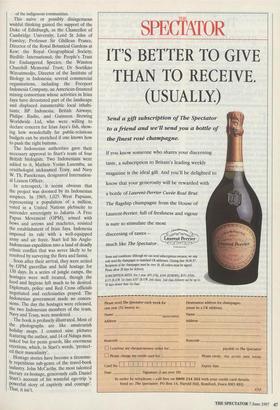Ego-trip to New Guinea
Patrick Skene Catling
THE OPEN CAGE: THE ORDEAL OF THE IRIAN JAYA HOSTAGES by Daniel Start HarperCollins, £16.99, pp. 338 Daniel Start's wanderlust was the initial cause of the trouble. As a schoolboy, Daniel bicycled across the Downs searching for 'mysterious and lonely antiquities'. Climbing past a 'Keep Out' sign, he tres- passed deep into woods, where, he relates, 'the trees seemed to hold me in a spell. I felt I belonged to something lost and ancient and I was filled with serenity.' He kept hoping to experience again that sort of epiphany.
'I would pour [sic] over my maps,' he writes, and walk, cycle, camp, explore and climb. He got more maps and travelled farther — to Transylvania and then Ugan- da. 'I walked alone in the rainforest, I breakfasted with chimpanzees and felt at one with nature.'
By the end of his first year as a Cambridge undergraduate, at the age of 19, he and his girlfriend had split up, he was unsure of other friends, 'claustropho- bia set in,' and he remembered Uganda. He longed for equatorial, snow-capped mountains.
Tracing the equator eastwards in an atlas, he came to New Guinea. The island is divided in two, with independent Papua New Guinea to the east and Irian Jaya, an Indonesian province about the size of France, to the west. Start consulted an encyclopaedia and perceived that Irian Jaya was his kind of place — mangrove swamps, lowland jungle, steep, forested valleys and Mount Jaya (16,400 feet), the highest peak in south-east Asia. He says he was spellbound.
He wondered whether any conservation work was being carried out there. It was to undertake a conservation project that he had been able to raise the money for the Uganda junket. He found that the Worldwide Fund for Nature (WVVF) had been interested in Irian Jaya for over 10 years and had proposed the establishment of protective national parks. The site he most liked the look of, from a distance, extended from Mount Jaya all the way down to the sea. This ecologically diverse 80-square-mile area was named Lorentz, after one Dr H. A. Lorentz, who explored it in 1911. Since then, according to Start, it had remained 'one of the least known tropical regions in the world'. Perfect. UP to a point . . . With great entrepreneurial persuasive- ness, he gathered sponsors for an Anglo- Indonesian Rainforest Conservation project he called Lorentz 95 to survey the flora and fauna of the Nduga, the aborigi- nal tribes of Irian Jaya.
I was convinced [he writes, and he convinced others] that a small team of biologists could be highly effective in documenting the pres- ence of rare or threatened species. This [Sic] data would support the area's conservation status and help protect the lands and forests
of the indigenous communities.
This naive or possibly disingenuous wishful thinking gained the support of the Duke of Edinburgh, as the Chancellor of Cambridge University; Lord St John of Fawsley; Professor Sir Ghillean Prance, Director of the Royal Botanical Gardens at Kew; the Royal Geographical Society; Birdlife International; the People's Trust for Endangered Species; the Winston Churchill Memorial Trust; Dr Soetikno Wiroatmodjo, Director of the Institute of Biology in Indonesia; several commercial organisations, including the Freeport Indonesia Company, an American-financed mining consortium whose activities in Irian Jaya have devastated part of the landscape and displaced innumerable local inhabi- tants; BP Indonesia; British Airways; Philipe Radio, and Guinness Brewing Worldwide Ltd, who were willing to declare concern for Irian Jaya's fish, show- ing how wonderfully far public-relations budgets can be stretched if one knows how to push the right buttons.
The Indonesian authorities gave their necessary approval to Start's team of four British biologists. Two Indonesians were added to it, Matheis Yosias Lasembu, an ornithologist nicknamed Tessy, and Navy W. Th. Panekenan, designated Internation- al Liaison Officer.
In retrospect, it seems obvious that the project was doomed by its Indonesian auspices. In 1969, 1,025 West Papuans, representing a population of a million, voted in a United Nations plebiscite to surrender sovereignty to Jakarta. A Free Papua Movement (OPM), armed with bows and arrows and machetes, resisted the establishment of Irian Jaya. Indonesia imposed its rule with a well-equipped army and air force. Start led his Anglo- Indonesian expedition into a land of deadly ethnic conflict that was never likely to be resolved by surveying the flora and fauna.
Soon after their arrival, they were seized by OPM guerrillas and held hostage for 130 days. In a series of jungle camps, the hostages were well treated, though the food and hygiene left much to be desired. Diplomats, police and Red Cross officials negotiated and ecclesiastics prayed. The Indonesian government made no conces- sions. The day the hostages were released, the two Indonesian members of the team, Navy and Tessy, were murdered. The book is profusely illustrated. Most of the photographs are like amateurish holiday snaps. I counted nine pictures featuring the author, and 14 of Nduga men, naked but for penis gourds, like enormous erections, which, in Start's words, 'protect- ed their masculinity'. Hostage stories have become a tiresome- ly repetitious sub-genre of the travel-book industry. John McCarthy, the most talented literary ex-hostage, generously calls Daniel Start's account of his wasteful ego-trip 'a Powerful story of captivity and courage'. That, it isn't.











































































 Previous page
Previous page